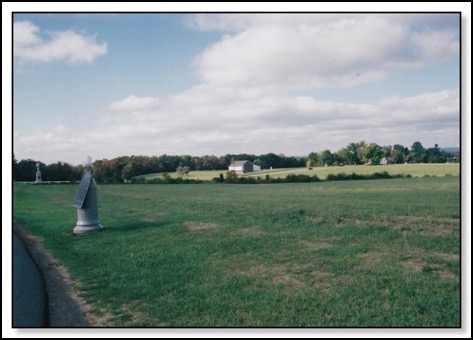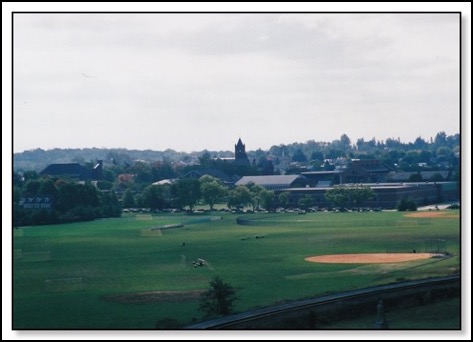Gettysburg at 150, First Day
01/07/13 21:23 Filed in: History
In 2001, shortly after 9-11 we traveled back to Philadelphia for a meeting. Afterwards, we spent time in parts of Pennsylvania, Washington DC, and Virginia. The major part of Pennsylvania was a visit to the Gettysburg Battlefield. What a special memory! We did a driving tour with audio (we still have the audio to listen to) around the various sites. It was a great overview though one never does get in everything. Today is the 150th anniversary of the first day of battle at Gettysburg.
Here is a modern day photo of the driving lane and monuments along the ridge where the first sightings and skirmishes occurred between the Boys in Blue and the Johnny Rebs. Did General Ewell lose the battle on this day by his actions? This area of McPherson’s Ridge was near to where we stayed in a B&B.

The town of Gettysburg, PA as you come up to it. It has much the same flavor as it must have in the days before the battle.


Gettysburg, Day 1
On the morning of July 1, Major General Henry Heth, of A.P. Hill’s Third Corps, sent his 7,500-man division down the Chambersburg Pike toward Gettysburg. Encountering resistance, they initially assumed it was more of the hastily assembled Pennsylvania Emergency Militia that they’d been skirmishing with during the campaign.
In reality, Colonel John Buford had deployed part of two brigades of Union cavalry as skirmishers in the brush along Willoughby’s Run three miles west of town. Just two weeks previously, they’d been issued breech-loading carbines, and they used the guns’ fast-loading capability to create the impression of a much larger force, slowing the advance of Hill’s brigades for a time before falling back.
The Confederates followed them across the stream, only to meet a line of Union infantry on McPherson’s Ridge. The Army of the Potomac was arriving piecemeal, and among the first to arrive was a brigade of Western regiments that had earned the nickname “Iron Brigade of the West.” Confederates recognized these “fellows in the black hats” and realized they were in for a rougher day than expected.
Union major general John Reynolds, commander of the left wing of the Army of the Potomac (I, III and XI corps), arrived and took charge of the defense. His men fought tenaciously, and Reynolds was shot dead during the fighting.
From his headquarters at Taneytown, Meade dispatched Major General Winfield Scott Hancock to take command at Gettysburg—although Major General O. O. Howard was already on the field—and assess whether or not the battle should be fought there. Hancock, seeing the strong defensive position offered by the hills near Gettysburg, chose to stand, and Meade ordered the other corps to the little crossroads town.
By afternoon, Confederate reinforcements had also arrived, and the general engagement Lee hadn’t wanted at this stage of the campaign was a fait accompli.
The Union’s XI Corps was driven back through the town of Gettysburg, losing 4,000 men, and by evening was entrenching on Culp’s and Cemetery hills south of town.
Lee expressed a desire for General Ewell to assault the hills without waiting for further reinforcement, but he failed to make it an express order. Ewell did not press his tired men forward, giving Meade time to reinforce the troops on the hills.
- See more at:
Here is a modern day photo of the driving lane and monuments along the ridge where the first sightings and skirmishes occurred between the Boys in Blue and the Johnny Rebs. Did General Ewell lose the battle on this day by his actions? This area of McPherson’s Ridge was near to where we stayed in a B&B.

The town of Gettysburg, PA as you come up to it. It has much the same flavor as it must have in the days before the battle.


Gettysburg, Day 1
On the morning of July 1, Major General Henry Heth, of A.P. Hill’s Third Corps, sent his 7,500-man division down the Chambersburg Pike toward Gettysburg. Encountering resistance, they initially assumed it was more of the hastily assembled Pennsylvania Emergency Militia that they’d been skirmishing with during the campaign.
In reality, Colonel John Buford had deployed part of two brigades of Union cavalry as skirmishers in the brush along Willoughby’s Run three miles west of town. Just two weeks previously, they’d been issued breech-loading carbines, and they used the guns’ fast-loading capability to create the impression of a much larger force, slowing the advance of Hill’s brigades for a time before falling back.
The Confederates followed them across the stream, only to meet a line of Union infantry on McPherson’s Ridge. The Army of the Potomac was arriving piecemeal, and among the first to arrive was a brigade of Western regiments that had earned the nickname “Iron Brigade of the West.” Confederates recognized these “fellows in the black hats” and realized they were in for a rougher day than expected.
Union major general John Reynolds, commander of the left wing of the Army of the Potomac (I, III and XI corps), arrived and took charge of the defense. His men fought tenaciously, and Reynolds was shot dead during the fighting.
From his headquarters at Taneytown, Meade dispatched Major General Winfield Scott Hancock to take command at Gettysburg—although Major General O. O. Howard was already on the field—and assess whether or not the battle should be fought there. Hancock, seeing the strong defensive position offered by the hills near Gettysburg, chose to stand, and Meade ordered the other corps to the little crossroads town.
By afternoon, Confederate reinforcements had also arrived, and the general engagement Lee hadn’t wanted at this stage of the campaign was a fait accompli.
The Union’s XI Corps was driven back through the town of Gettysburg, losing 4,000 men, and by evening was entrenching on Culp’s and Cemetery hills south of town.
Lee expressed a desire for General Ewell to assault the hills without waiting for further reinforcement, but he failed to make it an express order. Ewell did not press his tired men forward, giving Meade time to reinforce the troops on the hills.
- See more at:
blog comments powered by Disqus

